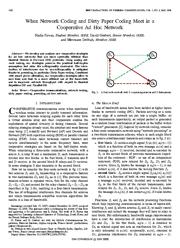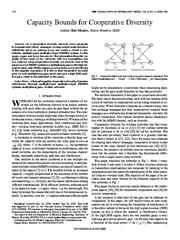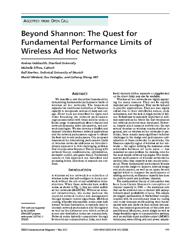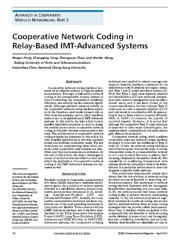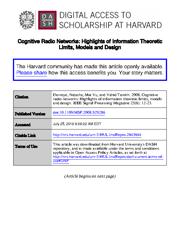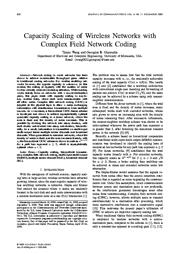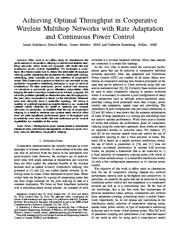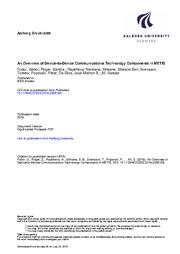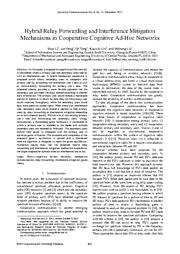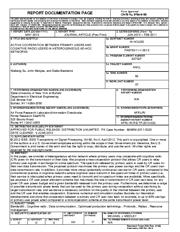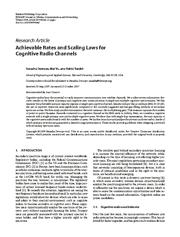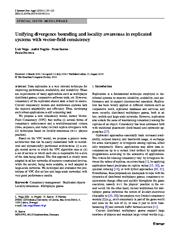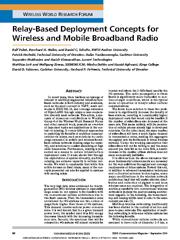The Internet Archive has a preservation copy of this work in our general collections.
The file type is application/pdf.
Filters
When Network Coding and Dirty Paper Coding meet in a Cooperative Ad Hoc Network
[article]
2007
arXiv
pre-print
We develop and analyze new cooperative strategies for ad hoc networks that are more spectrally efficient than classical DF cooperative protocols. ...
The introduction of interference due to non-orthogonality is mitigated thanks to precoding, in particular Dirty Paper coding. ...
ACKNOWLEDGMENT The authors would like to thank Samsung Advanced Institute of Technology, South Korea and the French Defense Body, DGA for supporting the work of Nadia Fawaz. ...
arXiv:0707.0978v1
fatcat:yf6nirmjlngg3onyzezfraeaiu
When network coding and dirty paper coding meet in a cooperative ad hoc network
2008
IEEE Transactions on Wireless Communications
Index Terms-Cooperative communications, network coding, dirty paper coding, precoding, ad hoc network. ...
The introduction of interference due to non-orthogonality is mitigated thanks to precoding, in particular Dirty Paper coding. ...
Nevertheless, in this paper developing a network coding approach for cooperative ad hoc networks, we focus first on functions performing a linear operation on symbols s 1 and s 2 , to simplify analysis ...
doi:10.1109/twc.2008.070786
fatcat:t2eme7uzijdevmt3doonwfk5lq
Capacity bounds for Cooperative diversity
2006
IEEE Transactions on Information Theory
In this paper, upper and lower bounds for the information-theoretic capacity of four-node ad hoc networks with two transmitters and two receivers using cooperative diversity are derived. ...
In a cooperative diversity network, users cooperate to transmit each others' messages; to some extent nodes therefore collectively act as an antenna array and create a virtual or distributed multiple-input ...
Cooperative diversity for wireless networks was first investigated by Sedonaris et al. in [12] - [15] for cellular networks and by Laneman et al. in [16] - [20] for ad hoc networks. ...
doi:10.1109/tit.2006.871576
fatcat:r3u2immttzg6laimmty7toraz4
Beyond Shannon: the quest for fundamental performance limits of wireless ad hoc networks
2011
IEEE Communications Magazine
We describe a new theoretical framework for determining fundamental performance limits of wireless ad hoc networks. ...
We also develop a flexible and dynamic interface between network applications and the network performance regions to obtain the best end-to-end performance. ...
described in this article. ...
doi:10.1109/mcom.2011.5762818
fatcat:zky4gvwl55gknjnwx2u7dp4wlu
Cooperative network coding in relay-based IMT-advanced systems
2012
IEEE Communications Magazine
In [8] , the authors investigated the benefits in terms of energy efficiency for broadcasting transmissions over ad hoc wireless networks, and proved that the network coding technique can offer a constant ...
Degrees of freedom could be provided by time, frequency, and space. The interference null space can be created using various techniques, such as beamforming, zero forcing, and dirty paper coding. ...
His research interests include radio resource management, network planning and optimization, cooperative communication, network coding, and self organization networking. ...
doi:10.1109/mcom.2012.6178837
fatcat:pxnsgfdstrenne3m37nlj6osra
Cognitive radio networks
2008
IEEE Signal Processing Magazine
Citation Devroye, Natasha, Mai Vu, and Vahid Tarokh. 2008. Cognitive radio networks: Highlights of information theoretic limits, models and design. IEEE Signal Processing Magazine 25(6): 12-23. ...
Published Version [ Highlights of information theoretic limits, models, and design ] ...
The performance of dirty-paper coding when this assumption breaks down has been studied in the context of a compound channel in [23] and in a channel in which the interference is partially known [24 ...
doi:10.1109/msp.2008.929286
fatcat:avelzyfg45axrmoieethlg3y5q
Capacity scaling of wireless networks with complex field network coding
2009
2009 IEEE International Conference on Acoustics, Speech and Signal Processing
Towsley, “The throughput order of number of posts, and is currently a Distinguished Lecturer for the IEEE-
ad hoc networks employing network coding and broadcasting,” ...
Tse, “Hierarchical cooperation IEEE Signal Processing (SP) and Communications Societies including
achieves optimal capacity scaling in ad hoc networks,” IEEE Trans. the G. ...
doi:10.1109/icassp.2009.4960111
dblp:conf/icassp/WangG09
fatcat:p3nipowumbhttbavjxsqgxkpsa
Capacity Scaling of Wireless Networks with Complex Field Network Coding
2009
Journal of Communications
Towsley, “The throughput order of number of posts, and is currently a Distinguished Lecturer for the IEEE-
ad hoc networks employing network coding and broadcasting,” ...
Tse, “Hierarchical cooperation IEEE Signal Processing (SP) and Communications Societies including
achieves optimal capacity scaling in ad hoc networks,” IEEE Trans. the G. ...
doi:10.4304/jcm.4.11.830-840
fatcat:3alnwfs6yjedpjjq6njydu4apq
Achieving Optimal Throughput in Cooperative Wireless Multihop Networks With Rate Adaptation and Continuous Power Control
2014
IEEE Transactions on Wireless Communications
We solve the problem optimally to obtain the max-min throughput for the case when cooperation is based on the distributed Alamouti code and networks have a mesh-like topology. ...
In particular, we establish that the use of cooperative relaying in a small to medium size random mesh network often does not yield significant performance gains in throughput and connectivity even when ...
as heterogeneous (e.g., [12] ), ad-hoc, etc. ...
doi:10.1109/twc.2014.2324583
fatcat:neva7n3odzdavfgeudcyebosfm
An Overview of Device-to-Device Communications Technology Components in METIS
2016
IEEE Access
advantages of properly combining cellular and ad hoc technologies help to meet the challenges of the information society beyond 2020. ...
In this paper, we review the METIS D2D technology components in three key areas of proximal communications-network-assisted multi-hop, full-duplex, and multi-antenna D2D communications-and argue that the ...
ACKNOWLEDGMENTS The authors would like to acknowledge the contributions of their colleagues in METIS, although the views expressed are those of the authors and do not necessarily represent the project. ...
doi:10.1109/access.2016.2585188
fatcat:p2ejmht23vglfbxnzkk7wnf6ea
Hybrid Relay Forwarding and Interference Mitigation Mechanisms in Cooperative Cognitive Ad-Hoc Networks
2013
Journal of Communications
In this paper, a cooperative cognitive ad-hoc network is considered where a primary user and secondary users coexist with an interference user. ...
With an aim of maximizing primary user's rate and minimizing the secondary users' energy consumption, a Stackelberg game framework is introduced in which a primary user is modeled as the leader and multiple ...
ACKNOWLEDGMENT The authors wish to thank the editors and reviewers for the valuable comments to improve this research. This work is supported by the National Natural Science ...
doi:10.12720/jcm.8.12.822-831
fatcat:e3dz72uoindgdoyubknu7mu3qu
Active Cooperation Between Primary Users and Cognitive Radio Users in Heterogeneous Ad-Hoc Networks
2012
IEEE Transactions on Signal Processing
maintaining the data needed, and completing and reviewing the collection of information. ...
Respondents should be aware that notwithstanding any other provision of law, no person shall be subject to any penalty for failing to comply with a collection of information if it does not display a currently ...
CONCLUSION In this paper, we proposed a cognitive cooperation protocol for cognitive heterogeneous ad-hoc networks, in which primary and CR users may actively cooperate for mutual benefits. ...
doi:10.1109/tsp.2011.2181841
fatcat:xymteqjqknc7fnrv7og7zbnmfy
Achievable Rates and Scaling Laws for Cognitive Radio Channels
2008
EURASIP Journal on Wireless Communications and Networking
These results provide guidelines when designing a network with secondary spectrum users. ...
Next, we consider a cognitive network with a single primary user and multiple cognitive users. ...
When nodes in the ad-hoc network use only the simple decode-andforward scheme without further cooperation, then the per user network capacity decreases as 1/ √ n as n→∞ [31, 32, 35] . ...
doi:10.1155/2008/896246
fatcat:tefkmjpjmja4dp3j2mb2hoiib4
Unifying divergence bounding and locality awareness in replicated systems with vector-field consistency
2010
Journal of Internet Services and Applications
We developed and evaluated two prototypes of VFC (for ad hoc and large-scale networks) with very good performance results. ...
The first approach is clearly more adapted to ad hoc networks of resource-constrained devices, while the second, being more scalable, is well adapted to large-scale networks. ...
Acknowledgements The authors would like to thank José Lopes, Tiago Bernardo, and Bruno Loureiro for their implementation work during several stages of VFC-related projects, as well as research project ...
doi:10.1007/s13174-010-0011-x
fatcat:ryc6u7tgaraopg76sbxax2z5v4
Relay-based deployment concepts for wireless and mobile broadband radio
2004
IEEE Communications Magazine
and coverage extension of HiperLAN/2 through relays or user-cooperative diversity mesh networks. ...
In recent years, there has been an upsurge of interest in multihop-augmented infrastructurebased networks in both industry and academia, such as the seed concept in 3GPP, mesh networks in IEEE 802.16, ...
of multiple-input multiple-output (MIMO) and so-called dirty paper coding techniques may lead to advanced multihop networks with high spectral efficiency. ...
doi:10.1109/mcom.2004.1336724
fatcat:jswweezpmzgmbapvvmnqcgzwke
« Previous
Showing results 1 — 15 out of 3,822 results

